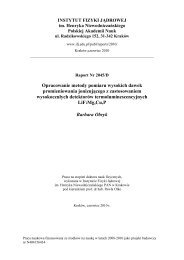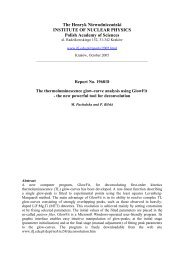Report No xxxx - Instytut Fizyki JÄ drowej PAN
Report No xxxx - Instytut Fizyki JÄ drowej PAN
Report No xxxx - Instytut Fizyki JÄ drowej PAN
Create successful ePaper yourself
Turn your PDF publications into a flip-book with our unique Google optimized e-Paper software.
DETERMINATION OF AMINO ACIDS IN BODY FLUIDS WITH THE<br />
US E OF 19 F NMR SPECTROSCOPY<br />
Przemysław Szczeciński, Dorota Bartusik<br />
Warsaw University of Technology, Faculty of Chemistry, ul. <strong>No</strong>akowskiego 3,<br />
00-664 Warsaw, Poland<br />
It is commonly known that amino acids play a very important role in living organisms.<br />
They are reactants as well as products of many biological processes and therefore their<br />
qualitative and quantitative determination in body fluids, e.g. urine or blood, is essential for<br />
1 13<br />
the diagnosis of numerous metabolic diseases. The usefulness of the H and C NMR<br />
spectroscopy for such determinations is well documented. However, body fluids, being multicomponent<br />
mixtures, give complex spectra, in which identification of the interesting signals<br />
may be often difficult. To avoid this problem the method of determination of amino acids<br />
with the use of 19 F NMR spectroscopy has been developed. Investigated compounds are<br />
transformed into fluoro derivatives (see Scheme 1) and then identified on the basis of their 19 F<br />
chemical shifts.<br />
HOOC CH R<br />
Cl<br />
N O 2<br />
NH<br />
CF H 3<br />
2 O<br />
NaHCO 3 O N<br />
CF<br />
+ R CH COOH 2 3<br />
EtOH<br />
NO 2<br />
NH 2<br />
Scheme1<br />
NO 2<br />
Because marker used is insoluble in water the reaction has to be performed in water-ethanol<br />
mixture. It was found that the presence of alcohol in measured sample noticeably influenced<br />
the fluorine signal positions. Therefore, to obtain reproducible results, ethanol has to be<br />
effectively removed prior to resonance measurement. It undesirably complicates the<br />
procedure of sample preparation. To overcome this problem we decided to use a marker<br />
soluble in water. We assumed that 4-chloro-3-nitro-5-trifluoromethylbenzenesufonic acid<br />
should fulfil this demand. Its synthesis is shown in Scheme 2.<br />
Cl<br />
Cl<br />
Cl<br />
CF<br />
3<br />
65 %<br />
fuming<br />
H 2<br />
SO 4<br />
CF 3<br />
fuming<br />
HNO 3<br />
O<br />
2<br />
N<br />
CF 3<br />
Scheme 2<br />
SO 3<br />
H<br />
30 %<br />
fuming<br />
H SO<br />
2 4<br />
SO 3<br />
H<br />
83

















